How is this one 22X22 ?
How is this not ?
I am always willing to correct if I am wrong
How is this one 22X22 ?
agni 6A new one 22x22
Guess for which mizzile
There are 11 tyres on each side.How is this one 22X22 ?
How is this not ?
I am always willing to correct if I am wrong
I think that's a generic vehicle used for testing purposes, not the final TEL.
None of the TEL are all terrain. Just road mobile
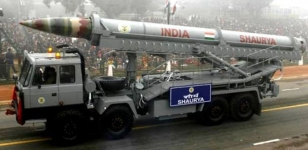
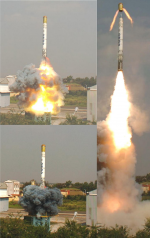
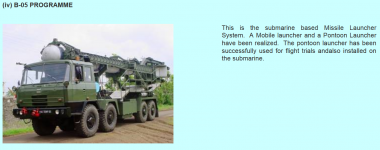
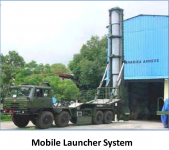
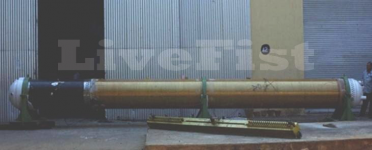
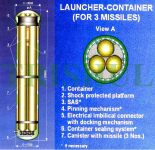
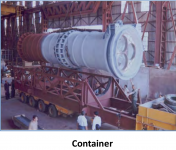
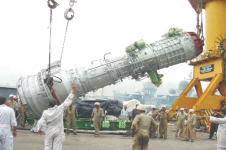
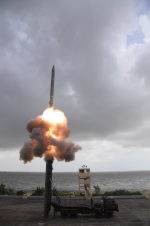
Any idea about weight? It cannot cross 3 ton to fit in with brahmos.For archival purposes a brief story of the evolution of the Shaurya family & some comments on it. Posting here as this might get lost on the other threads.
The initial version was a quintessential SRBM. Notice the missile's nose poking ahead of the truck's cabin.
View attachment 20919
The 1st modification came with the addition of the nose cap when the missile was decided to be deployed via silos.
View attachment 20918
The best video of the Shaurya's testing came during this period. I think this is the only video of the Shaurya out there, I could be wrong. The silo launched version was also tested at low altitudes flying at Mach 7. Initially the goal was to test if DRDO had the materials to survive a low altitude hypersonic flight. The transformation of the missile to a quasi-ballistic missile that could fly in cruise missile like trajectory had begun.
Video:
View attachment 20922
Soon enough there was a Submarine & Truck based version of this missile, named the K-15/BO-5/Sagarika:
View attachment 20913
View attachment 20911
Notice how, unlike the initial Shaurya, the nose cap sits behind the cabin. The trucks in both example is the same BEML truck so the missile has shrunk in length.
Submarine based launch tubes:
View attachment 20916
Sub based launch container set up:
View attachment 20917
Walchandnagar Industries supplied the launch containers:
View attachment 20912
Walchandnagar Industries also made the K4's launch tube but that's a different subject:
View attachment 20915
Anyway the development of the missile continues with the 650km ranged SMART missile:
View attachment 20921
The SMART doesn't seem to have the nose cap and is also cold launch. The SMART is based on the newer version of the Shaurya which was described by the media as lighter & sleeker missile that can travel to up to 800 Km.
If Shaurya's newer version has been reduced down to the size of the Brahmos than the VLS used by the Navy for the Brahmos can serve as the the base for the development of the UVLMs. The advanced Shaurya can serve as a stopgap hypersonic ASHM until the HSTDV based AShM/LACM &/or Brahmos-2 arrive. A Mach 7.5 cruise speed with 800 km range is a potent combination. The fact that the Navy operated the K15/BO-5 & in the future will operate the SMART means there is a compelling logistical case to be made as well.
Of course the Nirbhay's new version the ITCM, the upcoming Liquid fueled ramjet based LACM & the LA-LRCM etc. can also be designed to fit the Navy's Brahmos VLS. SAMs like the VL-SRSAM & the Barak-8 could be quad packed if they were cold launched. But they are both hot launched. With the VL-SRSAM we have already seen the 24 cell hot launch VLS module design. May be upcoming XR-SAM, AD-1 & 2 could be mated to the UVLMs, assuming they are navalised.
I will check back on this post when the UVLMs is revealed to see how many of my assumptions were right.
On the weight we don't have a number yet. The original Shaurya was 6.2 tons with a 1 ton warhead. Assuming we are not retaining that ridiculously heavy warhead & we are incorporating latest solid rocket technologies like composite casings on boosters etc. weight can be brought down to 3 tons.Any idea about weight? It cannot cross 3 ton to fit in with brahmos.
On the weight we don't have a number yet. The original Shaurya was 6.2 tons with a 1 ton warhead. Assuming we are not retaining that ridiculously heavy warhead & we are incorporating latest solid rocket technologies like composite casings on boosters etc. weight can be brought down to 3 tons.
The warhead will probably be around the <500 kg. The newer Shaurya has a reduced range of 800 km as opposed to 1900 km with a 200 kg warhead. the range reduction is probably due to the decrease in size & weight.
I don’t think even Russian fancy TELs go into trailing or crosscountry adventures or on front lines likes tanks and AFVs do.None of the TEL are all terrain. Just road mobile
Is it possible to compare TEL size with Brahmos to get an idea of diamentions? Thus weight.On the weight we don't have a number yet. The original Shaurya was 6.2 tons with a 1 ton warhead. Assuming we are not retaining that ridiculously heavy warhead & we are incorporating latest solid rocket technologies like composite casings on boosters etc. weight can be brought down to 3 tons.
The warhead will probably be around the <500 kg. The newer Shaurya has a reduced range of 800 km as opposed to 1900 km with a 200 kg warhead. the range reduction is probably due to the decrease in size & weight.
Weight & diameter would be difficult. I can do some guess work for the length though. Let's give it a shot:Is it possible to compare TEL size with Brahmos to get an idea of diamentions? Thus weight.
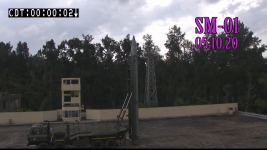
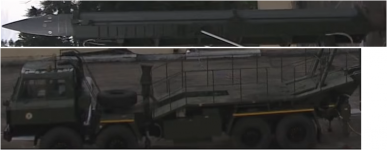
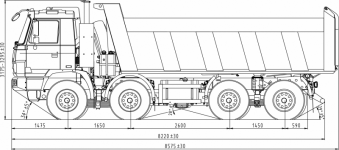
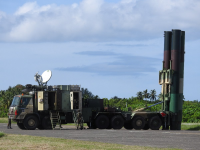

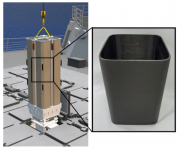
It seems a design study was conducted in 2017 for trying to fit a quad pack of smaller hot launched missiles into a naval cold launch set up.
View attachment 20948
The smaller hot launch missiles are the SAMs & the cold launch set up it like the Brahmos VLS or the upcoming UVLMs set up. The quad pack has a hot gas routing system at the bottom attached to it. In the pic above the gas can is shown in white colour. There are white coloured tubes rising up along side the launch cannisters. These tubes will re-route the hot gasses upwards when the missile is fires.
The tubes rising up seem quite thin. This type of quad packing will be restricted to smaller SAMs, so I guess there won't be a lot of gas to route up anyway. Also there are space & weight constraints so that might have played a role. You can also see coiled springs below the gas can. The springs are probably for damping the recoil force. The platform below the springs is a part of the cold launch set up. This is where all the launch tubes rests.
It is just a design study so there is no certainty of this being used. We might still end up with 2 separate launchers: a cold launch set up for AShMs/LACMs/heavy SAMs & a hot launch set up for tactical SAMs like Barak8/VL-SRSAM. I am not even sure if this is their own design or are they studying some foreign design.
But at least they are studying the possibility of quad packing tactical SAMs. So the probability of the DRDO's UVLMs being a truly universal VLS is high.
